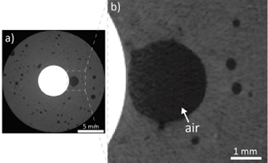X-ray computed tomography to observe the presence of water in macropores of cementitious materials
DOI:
https://doi.org/10.21809/rilemtechlett.2023.190Keywords:
X-ray Computed Tomography, Corrosion, Steel, ConcreteAbstract
Corrosion of steel reinforcement in concrete is a common degradation mechanism occurring in infrastructures worldwide. Even though extensive research has been conducted over the last decades to accurately predict the influence of steel corrosion on concrete durability, a comprehensive understanding of several micro-scale processes simultaneously involved in the corrosion mechanism is still lacking. The application of X-ray Computed Tomography (X-ray CT) can contribute to elucidate these processes, since this technique allows observing the internal status of specimens non-destructively, over time, and with a spatial resolution in the range of µm. Nevertheless, the relatively low sensitivity of light elements (e.g., hydrogen and oxygen) to X-ray CT may hinder the observation of solution within the cementitious matrix. This consideration is discussed in this letter. The results of this study show that the detection of solution in macropores (e.g., air voids) through X-ray CT is not limited by the relatively low attenuation coefficient of the fluid per se, but more by the spatial resolution at which acquisitions are performed and by the dimensions of the porous volume where solution penetrates. The observations reported in this letter may open several opportunities to further study the influence of the moisture conditions of air voids on several degradation mechanisms of reinforced cementitious materials (e.g., steel corrosion, freeze-thaw damage), which have been rarely investigated with X-ray CT according to the literature. The application of these findings could significantly deepen the understanding of several micro- scale processes that affect the durability of reinforced cementitious materials which still need to be elucidated, as further discussed in the present letter.

Downloads
Published
How to Cite
Issue
Section
License
Copyright (c) 2024 Emanuele Rossi, Susanna Governo, Mahdieh Shakoorioskooie, Qianru Zhan, Shishir Mundra, David Mannes, Anders Kaestner, Ueli Angst

This work is licensed under a Creative Commons Attribution 4.0 International License.
Authors retain copyright of the articles published in RILEM Technical Letters and grant the journal the right of first publication with open access. The work is simultaneously licensed under Creative Commons Attribution 4.0 International License (CC BY 4.0) that allows others to share and adapt the work under the following terms: 1) a proper attribution is given in a form of bibliographic record with the DOI link directing to RILEM Technical Letters; 2) a link to the license is provided; 3) the changes (if any) are indicated.









